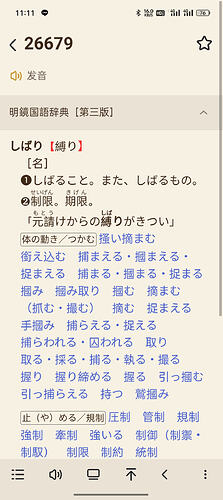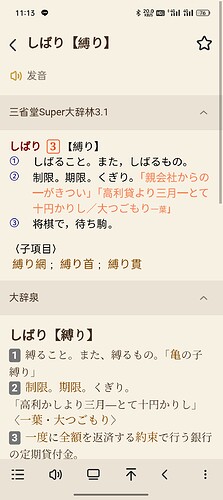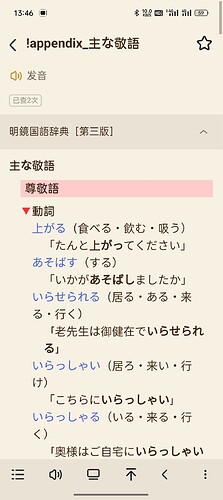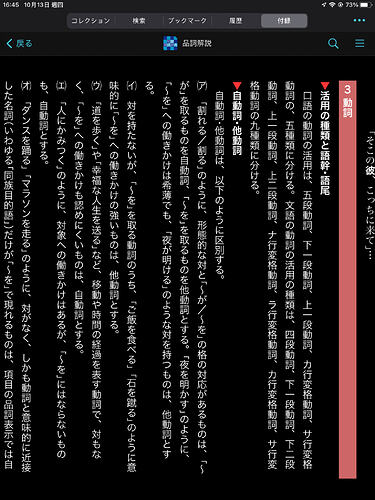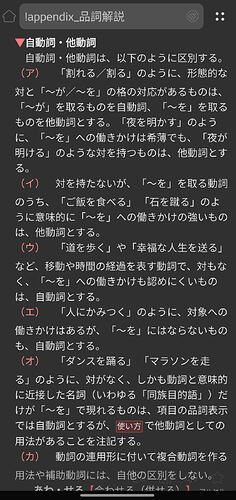I am not exactly sure why this is important. Could you please explain the issue to me?
In the eudic(欧陆词典)app,if I jump to another word in v1.1,it only show the number like this
You can’t search one word in the multi-dictionaries at the same time,like old version
I see what you mean. I do not believe href should be used for multi dictionary search because it is highly unreliable.
For instance, “しばり【縛り】” is formatted the same in both the dictionaries you have but that is just a coincidence. The same word in 新明解 is formatted as “しばり【縛(り)】”. This mean that you won’t get a multi dictionary match when clicking on a link.
It is this way because all dictionaries do not have the same formatting, for instance:
明鏡: とらえる【捕らえる・捉える】
大辞泉: とらえる【捕(ら)える/捉える】
大辞林: とらえる【捕える・捉える】
三国: とらえる【捕らえる】
岩波: とらえる【捕(ら)える・捉える】
日本国語大辞典: とらえる【捕・捉】
新明解: とらえる【捕(ら)える・捉える】
As you can see the entry is different for every single dictionary. This means you won’t get any multi dictionary match when clicking on a href link.
For this reason, I believe that href links should not be used for multi dictionary match altogether. The purpose of a href should be a reference within the same dictionary. Ultimately the source dictionary is referencing himself, not other dictionaries. You can always highlight the word and do a multi dictionary search may the need be.
I understand, thank you for your selfless efforts
Such “gaiji” tags in the appendix display as “?” too.
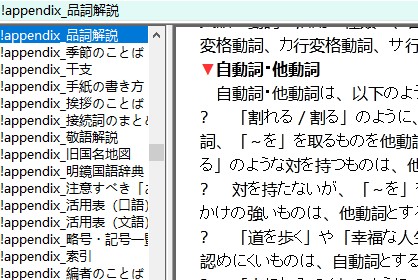
Yes I have noticed them but I don’t know what they should represent because I haven’t bought the application. These only appear in the appendix.
@lu2905363 Could you check for us?
Whoops, I’ll fix it,
Corresponding text in mdx shows:
自動詞・他動詞は、以下のように区別する。</meaning><meaning><num><gaiji style="glyph:10078;">?</gaiji></num> 「割れる<slash>/</slash>割る」のように、形態的な対と「~が<slash>/</slash>~を」の格の対応があるものは......
So there’s no svg reference and the question mark ?displays in raw html data as well:
I guess that’s the way dictionary authors trying to highlight a point here, so no need to worry.
That is how it looks in the original 物書堂 application?
Not sure. I didn’t purchase this dictionary, sorry
Oh I am sorry. You posted a screenshot from the ipad app so I assumed you owned the app!
Haha, it’s actually an official preview. I always think and weigh back and forth before purchasing digital items
“?”s in “取る” are just numbers of a counter. So I think we can just use a custom css style to display those “?”s without adding extra SVGs.
.body, .level0 {
counter-reset:section;
}
bc:before {
font-family: "Hiragino Kaku Gothic ProN";
counter-increment:section;
content:counter(section);
display: inline-block;
line-height:1.3em;
width: 16px;
height: 16px;
border-radius: 50%;
font-size: 13px;
font-weight: bold;
color: #FAFAFA;
text-align: center;
background: #000000;
position: relative;
margin: 0 2px 0px 1px;
}
bc {font-size:0;}
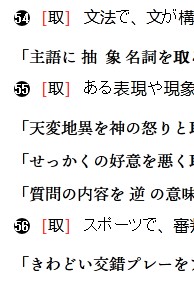
content:"("counter(section, katakana)")";
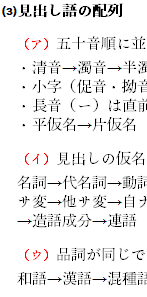
GoldenDict works just well.
Unfortunately MDict PC(IE engine) does NOT support “katakana” listStyleType. ![]()
num gaiji {font-size:0;}
num gaiji:before {
display: inline-block;
font-size: 16px;
color:red;
}
num gaiji[style*="10078"]:before {content:"(ア)";}
num gaiji[style*="10079"]:before {content:"(イ)";}
num gaiji[style*="10080"]:before {content:"(ウ)";}
num gaiji[style*="10081"]:before {content:"(エ)";}
num gaiji[style*="10082"]:before {content:"(オ)";}
num gaiji[style*="10083"]:before {content:"(カ)";}
num gaiji[style*="10084"]:before {content:"(キ)";}
Final solution to display these "gaiji"s correctly.
Where do I paste it in the .css file?
Wherever you like or JUST the end of it.
Restart your software for the changes to take effect.
